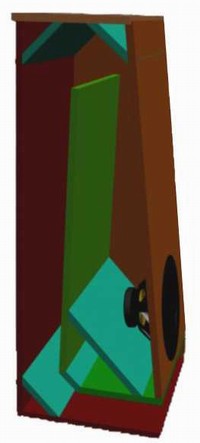Rapture Audio System
Text has not been updated or edited.
Subwoofer Enclosure Types
Because an Electrostatic Loudspeaker is incapable of producing low frequencies, a tradeoff must be made. Therefore, for a standard dynamic loudspeaker is used. It is then of paramount importance to design the enclosure for the dynamic subwoofer to be as accurate as possible to match the ESL. There are three main speaker enclosure types for the general consumer: acoustic suspension (sealed), bass reflex (vented), and compound (bandpass). Each one of these designs has variations but are similar enough to be ignored for our purposes. Each type of enclosure makes tradeoffs between efficiency, frequency response and accuracy.
By far, an acoustic suspension yields the very best accuracy. The air in the box acts like a spring, and counteracts the motion of the diaphragm. This helps to decrease the amount of over and under shoot giving the sealed enclosure very tight and defined bass. It also tends to protect the speaker from extreme excursion that would cause the cone or voice coil to "bottom out" or hit the frame, damaging the speaker. However, like any spring system, there is a resonance, and below this resonance, the output falls away at about 6db per octave. Also, due to the speaker having to fight the air spring or compliance of the box, the efficiency is low.
The bass reflex or vented enclosure has a greater efficiency. The back wave (sound from the back of the speaker diaphragm) that would normally be dissipated as heat in the enclosure is channeled out through a tuned vent to add with the front wave. In this way, the system is more efficient, but does not have the protection of the air spring. The frequency response tends to be not as flat as sealed. Furthermore, the tuned resonant system has very poor response below the resonance point and can be easily damaged, as the diaphragm decouples from the air and can bottom out with no air spring protection.
The compound or bandpass enclosure is composed of mounting the loudspeaker in a combination of vented and or sealed enclosures in front and behind. The most used is the 4th order bandpass enclosure, where one side of the speaker is in a sealed box and one side is in a vented box. This allows for a double tuned system that has very high efficiency in its pass-band range. However, like the vented box, anything outside of the range is severely attenuated. Also it is difficult to design properly and easy to abuse. The bandpass enclosure is not for audiophiles and tends to give the "one-note-thumper" sound of teenage car audio systems.
Transmission Line Basics
For more information on speaker enclosure types, please refer to The Subwoofer DIY Page
Design Highlights
The enclosure will be a sloped front folded transmission line. This will decrease the area of parallel sides. It will be about 20 inches wide, 12 inches deep and about 4 feet tall. The sloped front also helps to create the tapered cross section with the vent on the floor for best room lift and to increase the apparent size of the line. There are only two folds. The corners, although baffled with MDF will then be rounded out with fiberglass and the entire enclosure will be damped.
